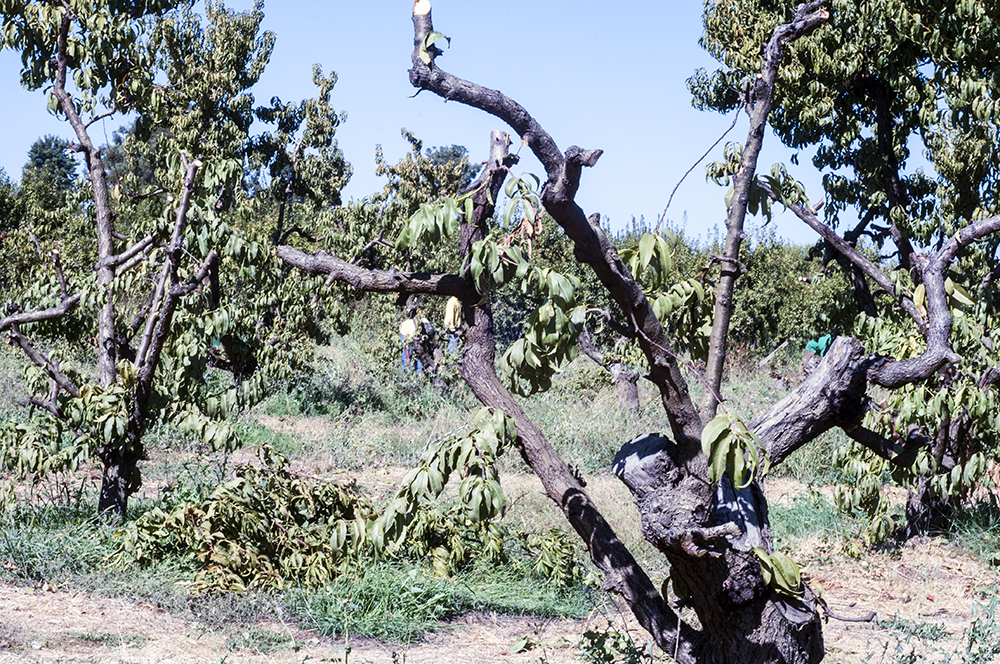THIS WEEKS FRUIT
Emerald Beaut Plums
A freestone plum, the Emerald Beaut is a delicate green that turns golden with a hint of a blush. It has a firmer texture than the Santa Rosa with a crisp almost crunchy mouthfeel. One of our most hardy fruit, the Emerald Beaut just gets sweeter and sweeter without losing texture as it ages.
Warren Pears
The Warren pear has a classic European texture – very soft and juicy – with a silky sweetness that avoids the typical grittiness found in most varieties.
Shinko Pears
The Shinko is a large pear with its round shape slightly flattened. The skin is bronze with brown russeting and its juicy, creamy white flesh has a subtly rich flavor. One of the last pears to pick, it comes off the tree with a butterscotch note to its sweetness. Shinkos are harvested in mid- September.
Fuji Apples
Cuyama, New Cuyama, CA
Fujis are a cross between Red Delicious and Ralls Janet, an heirloom apple dating back to Thomas Jefferson. Fujis are loved by many for their crisp, sweet, and juicy character.
Hass Avocados
Abounding Harvest, Los Gatos, CA
Creamy in texture, nutty in flavor, with a small to medium seed. The Hass skin is easy to peel and darkens from green to purplish-black as it ripens. Store on the counter out of direct sunlight.
Valencia Oranges
Sundance Organic, Sundance, Oceanside, CA
Valencia Oranges are a late season orange known for their very sweet tasting and brightly colored juice. They are one of the most popular varieties used for bottled juices because of this. Their sweet, bright flavor and minimal seed content (1-6 per orange) make them perfect for out of hand eating too.
A NOTE FROM FARMER AL
The Giving Trees
After 30 years in the ground, growing and producing peaches that thrilled thousands of people, our old Cal Red trees are being pulled out to be replaced by younger, more vigorous trees – the next generation.
I’m very sad to see them go, but this last summer it was even sadder when at least 10 of them collapsed and cracked under the weight of the heavy crop. Their thick trunks split in half, the bark is cracked and darkened by years of sunburn. It’s most unsettling to see a once noble tree laying on the ground with hundreds of ripe peaches still clinging to the branches.
I planted the first Cal Red orchard in 1977. Back in those days my 13 acres
of trees were sold via the “u-pick” system. Just a few years later those first
Cal Reds were discovered by a loyal following of u-pickers who came from Oakland and San Francisco with their families. The word about the Cal reds seemed to spread like wildfire and caravans of family and friends would drive out to get those “reds”. I can’t believe I sold them for only 25¢ a pound! People would come back with buckets overflowing with heavy fruit; an amazing sight, indeed!
Now, 30 years later, big semi-trucks pulling long refrigerated vans pull up to our packing shed each day of the summer to load pallets of perfectly packed fruit, destined for Bay Area markets and beyond. At the beginning of the day, each peach must still be chosen and picked by hand, one at a time, at just the right moment of ripeness, and placed carefully in the pickingtote so as not to be bruised.
Today, Sunday, (the day before the chainsaws will quickly do their work) I walk through this orchard with sadness, remembering these amazing trees that stood tall and sturdy with what seemed to be infinite productive life.
Then I think of the 600 new trees planted in the orchard around my house, and how much they’ve grown since we planted them just three growing sea- sons ago. The increase in production of those new vigorous trees from 2014 to 2015, will more than cover the loss of production from these old beauties, so their removal will not even be noticed by accountant or bankers when adding up the harvest numbers at the end of 2015. But I notice. I am always in awe at the nobility, grace and life force of a tree with hollowed out trunks, sunburned bark and bent branches, still reproducing, still giving.

 Follow
Follow


